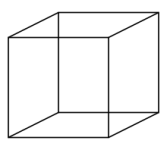Copernicus
Industrial Grade Linguist
People spend a lot of time discussing the nature of consciousness here. I would like to explain to some aspects of it that you are aware of but may not have paid sufficient attention to regarding this subject.
Consider what differentiates the meaning of word pairs like "see" and "look" or "hear" and "listen":
1) The boy saw/looked at the radio.
2) The boy heard/listened to the radio.
The verbs "see" and "hear" describe acts of awareness. The verbs "look" and "listen" describe acts of attention to awareness.
The brain is a machine that continuously receives and interprets different types of sensations. It is aware of these sensations subconsciously, but it selectively pays attention to them. Awareness of the simultaneity of sensations gives meaning to words like "here" and "now". That awareness of simultaneous sensations is what we understand the present tense of verbs to refer to. Words like "then" and "there" contrast the present with a remembered simultaneity or "situation". So the mind "situates" reality on the basis of comparing and contrasting its ongoing sensorium with memories and imagination. Situated awareness is always a part of the "background noise" in our stream of consciousness.
To understand what consciousness is, you have to consider how attention works. Different types of unattended awareness (seeing, hearing, touching, tasting, etc.) are going on all the time in a brain, but they are "subconscious". They take place in the dark, so to speak. When the mind focuses attention on some singular instance of awareness, it is like shining a flashlight on something in the dark. Suddenly that thing springs into the foreground. This flashlight of consciousness can be focused anywhere on background "subconscious" awareness, so who is holding that light and why does that agent illuminate different places in its sensorium or running train of thought?
I have more to say, but I'll pause here and let folks mull that over. This is the point where people start thinking about free will and agency. What is paying attention to different pieces of this chaotic hodgepodge of awareness roiling around in the brain? What continuously changes the contrast between foreground and background? I'll give my take on it later, but that is the question I want to put to you. Think about what you do when your attention moves from one thing to another.
Consider what differentiates the meaning of word pairs like "see" and "look" or "hear" and "listen":
1) The boy saw/looked at the radio.
2) The boy heard/listened to the radio.
The verbs "see" and "hear" describe acts of awareness. The verbs "look" and "listen" describe acts of attention to awareness.
The brain is a machine that continuously receives and interprets different types of sensations. It is aware of these sensations subconsciously, but it selectively pays attention to them. Awareness of the simultaneity of sensations gives meaning to words like "here" and "now". That awareness of simultaneous sensations is what we understand the present tense of verbs to refer to. Words like "then" and "there" contrast the present with a remembered simultaneity or "situation". So the mind "situates" reality on the basis of comparing and contrasting its ongoing sensorium with memories and imagination. Situated awareness is always a part of the "background noise" in our stream of consciousness.
To understand what consciousness is, you have to consider how attention works. Different types of unattended awareness (seeing, hearing, touching, tasting, etc.) are going on all the time in a brain, but they are "subconscious". They take place in the dark, so to speak. When the mind focuses attention on some singular instance of awareness, it is like shining a flashlight on something in the dark. Suddenly that thing springs into the foreground. This flashlight of consciousness can be focused anywhere on background "subconscious" awareness, so who is holding that light and why does that agent illuminate different places in its sensorium or running train of thought?
I have more to say, but I'll pause here and let folks mull that over. This is the point where people start thinking about free will and agency. What is paying attention to different pieces of this chaotic hodgepodge of awareness roiling around in the brain? What continuously changes the contrast between foreground and background? I'll give my take on it later, but that is the question I want to put to you. Think about what you do when your attention moves from one thing to another.

